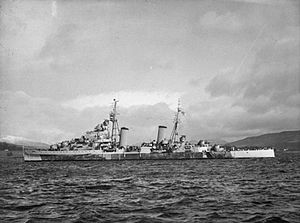HMS Cleopatra (33)

Cleopatra at anchor in the Clyde, April 1945
|
|
| History | |
|---|---|
|
|
|
| Name: | HMS Cleopatra |
| Builder: | Hawthorn Leslie and Company, (Hebburn-on-Tyne, UK) |
| Laid down: | 5 January 1939 |
| Launched: | 27 March 1940 |
| Commissioned: | 5 December 1941 |
| Decommissioned: | 15 February 1953 |
| Fate: | Scrapped, Arrived at Newport to be scrapped by J Cashmore on 15 December 1958. |
| General characteristics | |
| Class and type: | Dido-class light cruiser |
| Displacement: |
|
| Length: | |
| Beam: | 50 ft 6 in (15.39 m) |
| Draught: | 14 ft (4.3 m) |
| Installed power: | 62,000 shp (46,000 kW) |
| Propulsion: |
|
| Speed: | 32.25 kn (37.11 mph; 59.73 km/h) |
| Range: | |
| Capacity: | 1,100 short tons (1,000 t) fuel oil |
| Complement: | 480 |
| Sensors and processing systems: |
list error: mixed text and list (help)
|
| Armament: |
|
| Armour: |
|
| Notes: | Pennant number 33 |
list error: mixed text and list (help)
Radar
HMS Cleopatra was a Dido-class cruiser of the Royal Navy. She was built by R. and W. Hawthorn, Leslie and Company, Limited (Hebburn-on-Tyne, UK), with the keel being laid down on 5 January 1939. She was launched on 27 March 1940, and commissioned on 5 December 1941.
Cleopatra went out to Gibraltar early in 1942, and on 9 February she sailed for Malta, where she was immediately damaged by a bomb. After repair, she was transferred to Alexandria in early March for the 15th Cruiser Squadron. She was Admiral Philip Vian's flagship during the Second Battle of Sirte, when his group of four light cruisers and 17 destroyers held off an Italian force which included the battleship Littorio, two heavy cruisers, a light cruiser and 10 destroyers, which had all been sent to intercept their convoy to Malta. During the engagement, Cleopatra´s radar and wireless stations were wrecked by a 6" round fired by the Italian light cruiser Giovanni delle Bande Nere. Other reports state that Cleopatra's after turrets were also damaged. In June 1942, she covered Operation Harpoon and Vigorous, and in August bombarded Rhodes as a diversion for the Operation Pedestal convoy.
Cleopatra was drydocked in Massawa on 19 September 1942 for minor repairs and cleaning and was undocked five days later. During the refloating, she slipped on the angled drydock, crushing every wooden keel block on the dock but sustaining little hull damage to herself. Captain G. Grantham considered the resulting leak a minor nuisance and ordered Cleopatra to return to service.
...
Wikipedia
